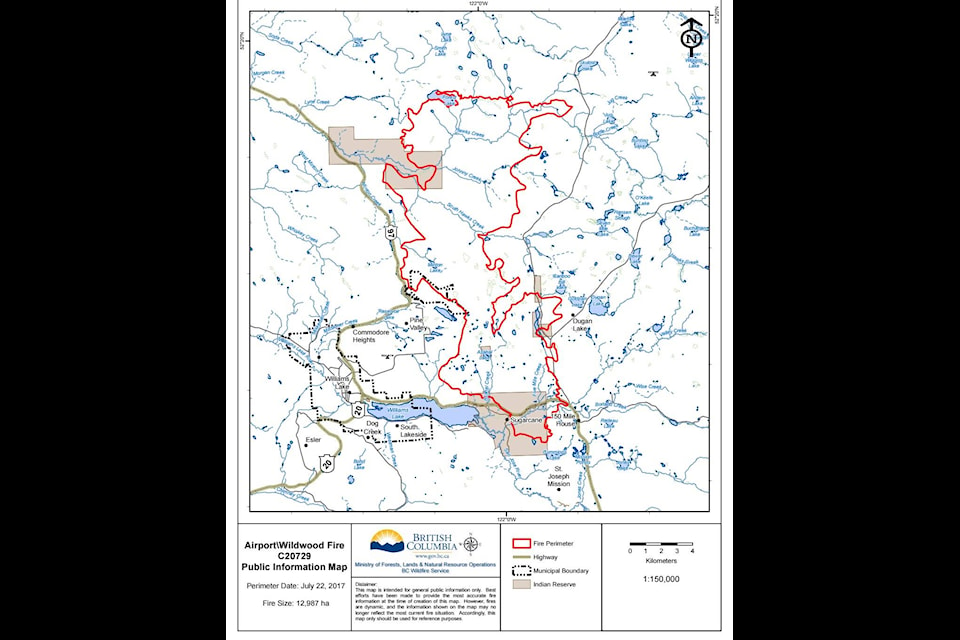When Deep Creek First Nation was given an evacuation order Andrea Gilbert said she and her husband Kelton William decided they could not leave.
“There was no way to get immediate help to fight the wildfire and we felt we could not just walk away,” Gilbert told the Tribune. “This is all we have so it was not really a choice.”
About 20 people stayed behind to help while most people in the community, which is located half an hour north of Williams Lake on Highway 20, left because the smoke was affecting their elders and children.
It all happened so fast, Gilbert said.
On the afternoon of Friday, July 7 she had just returned from picking up some workers at nearby Blue Lake.
“There was barely a cloud in the sky when I saw lightning strike northwest of Soda Creek. I said a prayer that it wouldn’t happen in Deep Creek. Unfortunately that prayer wasn’t heard.”
A community member, Tristan Sellars, was working in the fields for his dad and he saw the lightning strike near him and then on the mountain, Gilbert said.
“When he turned the tractor around he could see fire by his aunt Karen’s place and he called his dad right away.”
Without taking time to really think about it, Gilbert said she and her husband Kelton William started running around trying to help people and keep the fire out of the reserve.
“We had garden hoses and Kelly Sellars from our band council had a water tank on the back of a trailer. He had a pump and was filling it up at Hawks Creek that comes in at the south end of the reserve. He was watering the hay fields because we figured if it hit those it would go right through the reserve and we wouldn’t be able to control it.”
Gilbert said the fire came close to Karen Sellars’ mobile home and field surrounding her place on the south end of the reserve.
At Ralph and Marge Sellar’s place a shed burnt down and even though Cheryl Chapman’s place has a swampy area nearby the fires kept coming up behind it.
Eventually help arrived from outside the community.
Jay Camille came with manpower and equipment and a crew began creating fire guards with dozers all around the community.
A helicopter pilot directed people on the ground where the fire threats were and began dropping water from the air.
The community is divided into two sections, with some people living at Deep Creek and others living at Soda Creek down below the highway towards the Fraser River.
Gilbert said Soda Creek became threatened by fires when the White Lake wildfire crossed the river at the Rudy Johnson Bridge.
“That’s where our fishing grounds are. We were kind of worried and we had people going back and forth between Soda Creek and Deep Creek keeping an eye on the water because we are on reservoirs up here.”
Firefighters from the community were doing control burns as well to widen some of the fire guards.
On Saturday, July 15 when the wind picked up it also stoked fires near Deep Creek.
“We were lucky because on the west side of us we have the creek that runs through and they did bring the water bombers in then.”
Gilbert said her husband helped fight the wildfire at Forest Lake as well.
“While we were there putting out the hot spots an officer pulled up and was shaking one of the guys’ hand and thanking us for putting up the fire guards on the south end of Forest Lake. He said if we hadn’t put up the fire guard his uncle’s cabin would have been lost.”
Most members of the community went to Prince George as evacuees and many have been camping at West Lake Campground, just outside the city.
Gilbert has been checking up on people’s animals, especially for her neighbour who has young children.
“Her youngest was supposed to go for surgery at Children’s Hospital so she had to get to Prince George and she asked me if I could watch her dog,” Gilbert said. “You do what you can do.”
Thankful to everyone that stayed behind, Gilbert said if they were not there to fight for the houses south of the reserve she wondered if there would be any homes left in Deep Creek.
“We did what we thought was required,” she added. “No disrepect to the B.C. firefighters - we are grateful, but they couldn’t be everywhere. Like the other First Nations and ranchers out west…we were the first line of defence in a rural area.”
